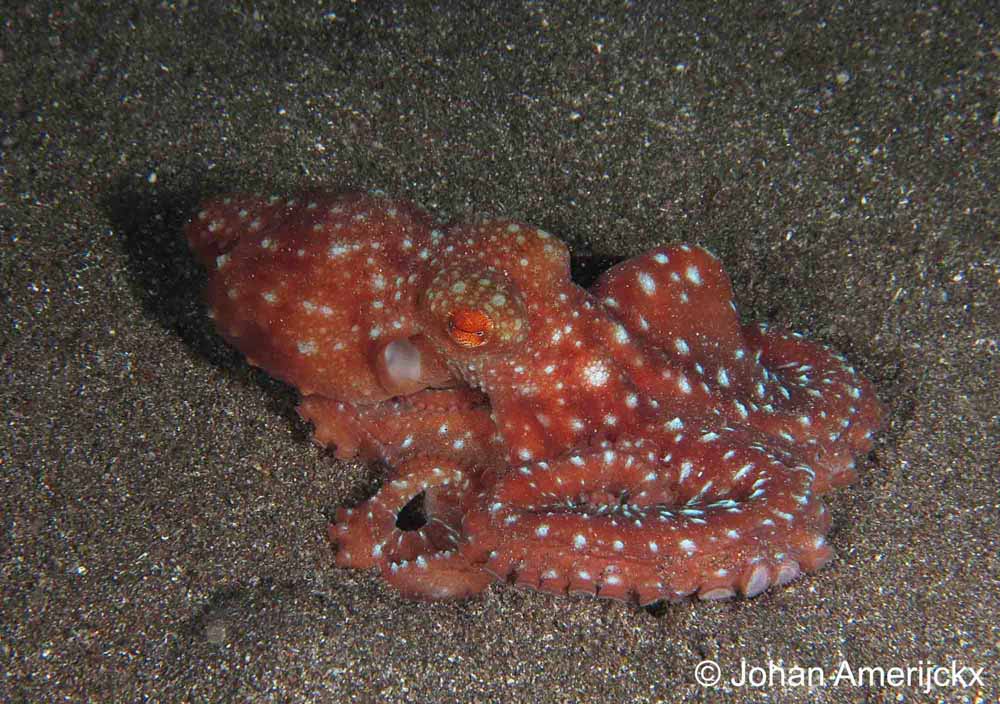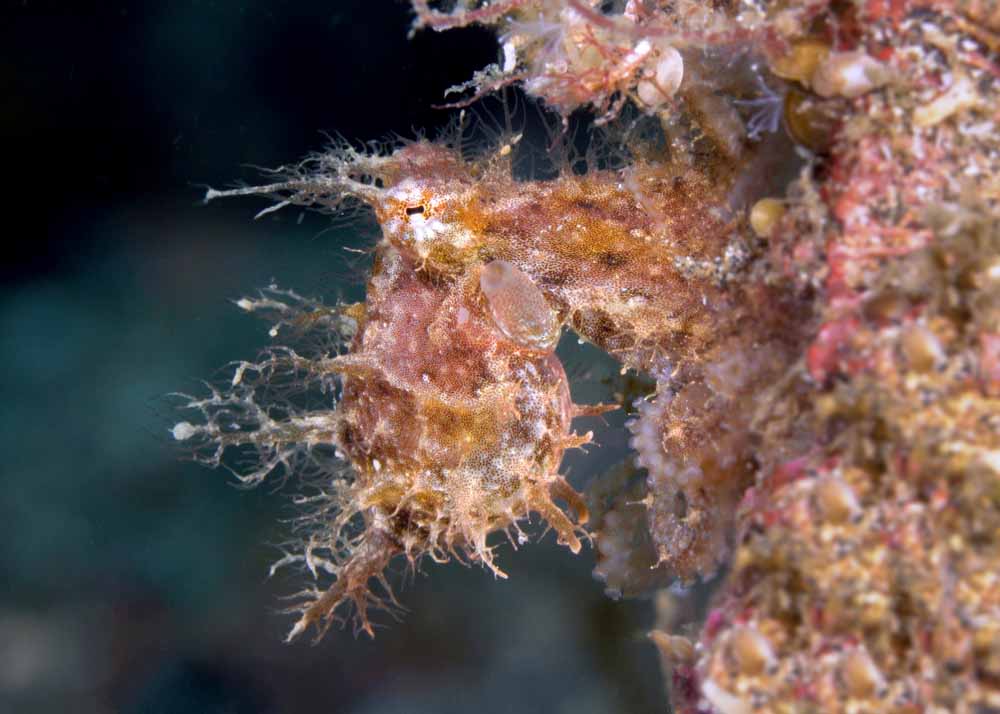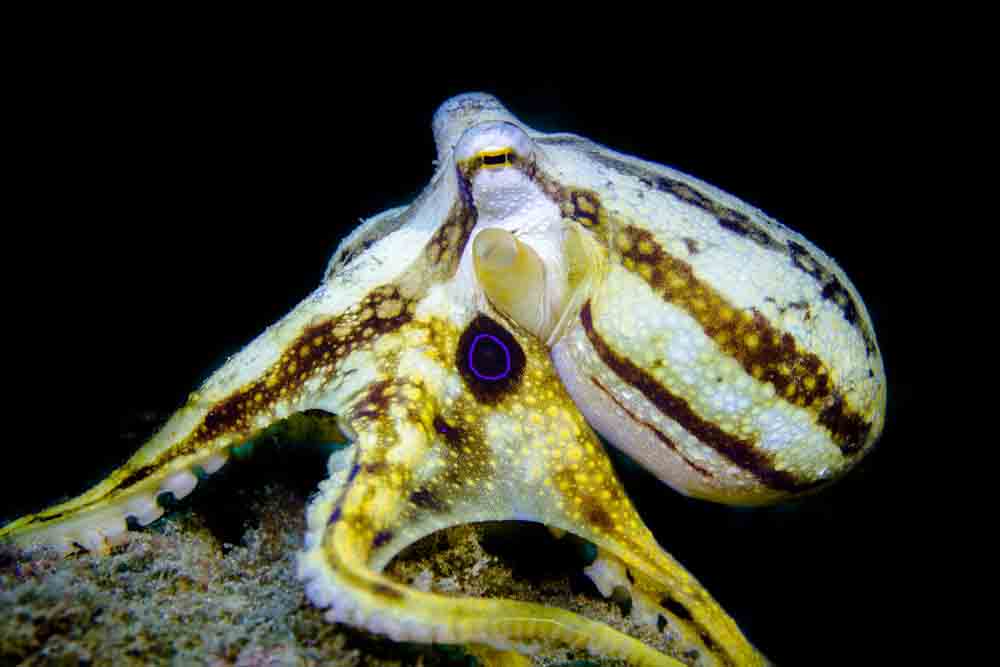
Ultimate Guide to North Sulawesi Octopus
Did you know that North Sulawesi is a haven for octopus? It’s not just because we have large numbers of North Sulawesi Octopus (which we do), but also because we have such a huge range of species and after over 25 years of diving here we still keep finding new ones!
The Octopus family is one of the most incredible and fascinating groups of marine life in the ocean and people know so little about them. We all know that they have 8 arms but did you know that they are one of the most intelligent species on the planet and that they have more than one heart?
In keeping with the theme of their 8 arms, read on to find out more about our favourite 8 species we have here in North Sulawesi and our best dive sites in Manado, Bunaken and around Bangka…..
1. Long Arm Octopus (Abdopus sp.)
Measuring just 6cm long, this small octopus is native only to the Indo-Pacific region. In North Sulawesi, we can find them in sandy areas like bays and lagoons. For example, at City Extra dive site, just off Murex Manado Resort and Peter’s Sponge dive site in Bangka. Also, we usually see this species between 5–20 meters, so all levels of divers can potentially enjoy an encounter.

The Long-arm Octopus is only found in the Indo-pacific region (that’s why it’s also known as the Indonesian Long-arm Octopus)
2. Blue Ring Octopus
The blue-ringed octopus is recognized as one of the world’s most venomous marine animals. Despite measuring just 12–20 cm (5–8 in), they can be incredibly dangerous (even deadly) to humans if provoked. Nevertheless, they are a truly awe-inspiring sight on dives in North Sulawesi.
The best dive sites for blue-ringed octopus are our House Reef, directly in front of Murex Bangka Resort (where they hide in rock pools at low tide); and also at Peter’s Sponge, in Bangka.

The Blue-Ringed Octopus is recognized as one of the world’s most venomous marine animals
3. Coconut Octopus (Amphioctopus marginatus)
Sometimes referred to as the ‘veined octopus’, the coconut octopus is highly intelligent. The name comes from their ability to ‘build’ shelters for themselves out of shells and the husks of coconuts. This use of tools, and the evidence of forward planning in their behavior, makes them a fascinating species to observe.
Here in North Sulawesi, our top spots for sightings include Paradise Pier in Bangka, along with Bethlehem and City Extra in Manado.

4. Mimic octopus (Thaumoctopus mimicus)
The mimic octopus is quite small, growing to a total length of about 60 cm (2 ft). To warn off predators, they can change their body shape to imitate other, more dangerous species. Some of its ‘impressions’ include crabs, jellyfish, and even sea snakes.
Our guides have enjoyed some amazing sightings recently at Paradise Pier in Bangka, as well as at City Extra and Bethlehem in Manado. For guides and guests alike, seeing one of these incredible creatures in the wild is a truly unforgettable experience.

Our guides often spot just the Mimic Octopus’ eyes peering out from its hole in the sand.
5. Wunderpus (Wunderpus photogenicus)
Like the mimic octopus, the wunderpus is another species that was first discovered here in Sulawesi. What’s more, it also has the ability to impersonate other marine species. One feature that sets them apart is the eyes; the mimic has eyes on short stalks, whereas wunderpus eye stalks are elongated. This gives them a permanently ‘alert’ appearance.
If you want to see a wunderpus with us here at Murex, we recommend you head to Sampiri 1, 2, or 3. These are our best spots for sightings.

6. Starry Night Octopus (Octopus luteus)
We occasionally spot this rare species during night dives on coral rubble and sand, or on patches of rocky coral reefs. This reddish-brown octopus displays white, star-like spots all over its body when it becomes agitated or threatened.
The best places for sighting this octopus species in North Sulawesi are City Extra and the Murex Manado House Reef. They can be pretty quick, so keep your camera at the ready!

This, usually reddish brown coloured Starry Night Octopus, displays white star-like spots all over its body.
7. Hairy Octopus (Octopus sp. undescribed)
The hairy octopus has not yet been officially described, but they do exist! We occasionally find this species at our Sampiri dive site in Bangka, but it can be hard to spot. This is because they are small (only 1.5–5 cm long), and because its hairy appearance makes it a master of disguise.
There are several variations in terms of color, but it commonly ranges from white and cream to brown and red, usually with a form of patterning like spots. It’s easy to mistake this little critter for seaweed, or even an orangutan crab – so look closer and you might be pleasantly surprised!

Its hairy appearance makes the Hairy Octopus a master of disguise. Image ©Sascha Janson uw-pix.com
8. Poison Ocelot Octopus (Octopus mototi)
Not enough rings to be a blue-ringed? Too beige to be a coconut octopus? Then you’re probably looking at the very rare poison ocelot octopus. This rather small species can be easily identified by its two blue rings (one on each side) that it displays when excited or threatened.
This is an elusive species, usually found in natural crevices or in man-made hideouts. Look out for them in crevices, coral rubble patches, and sea grass beds, or in bottles, cans, and shells. The best dive sites to search for them are Air Prang, Jahir, and Hairball, in Lembeh.

This rather small Mototi Octopus can be easily identified by its two blue rings (one on each side). Image ©Sascha Janson uw-pix.com
9. Reef Octopus (Octopus cyanea)
Also known as the big blue octopus or day octopus, this species can grow to 16 cm in body length, with arms more than 80 cm long. They have an amazing capacity for mimicry and camouflage – one researcher recorded more than a thousand changes in its appearance over a period of just 7 hours!
10. Mosaic Octopus (Abdopus abaculus)
This captivating species of pygmy octopus gets its name from its coloration and eye-catching markings. They are usually dark gray or dark purple, with distinctive mottling patterns in cream or light purple spots. Mosaic octopus can usually be found close to the surface, at depths of just 0–5 meters, making them easily accessible to most divers and sometimes even snorkelers!
11. Algae Octopus (Abdopus aculeatus)
Illusive algae octopus tend to live in areas with lots of cover. This includes sea grasses, rubble, and reefs, where they hide away in dens built into the sandy bottom which they line with pebbles. This behavior is supported by their camouflage – with ochre, gray, and brown coloration, they blend seamlessly into their surroundings. Interestingly, the algae octopus is the only species occasionally seen on land, as it sometimes makes its home in the rock pools of beaches and can be seen moving from one to another in search of crabs.
Next time you visit Murex, keep an eye out for some of these 11 octopus species of North Sulawesi. Each sighting is a moment you will remember forever. In the meantime, if you want to learn more about our marine life and dive sites, or you want to book your next diving expedition, you can email us at reservations@murexresorts.com.
To watch our latest video of the octopus of North Sulawesi, click the link below:




